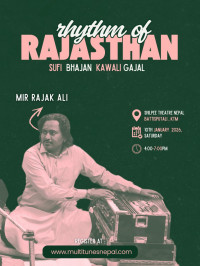Culture & Lifestyle
Nepali theatre’s dilemma
As Nepali theatres in the Valley come back to life after the lockdowns, foreign adaptations are dominating the theatre scene.
Shranup Tandukar
On the evening of October 2, the audience at Shilpee theatre were transported to 1600s’ France. Before them, theatre artists performed the famed pastoral comedy ‘As You Like It’ written by William Shakespeare, which was adapted and directed by Greta Rana. The play was conducted from October 1 to October 4.
Arahat Sundar Tuladhar, 27, who used to take part in theatre plays during his school days, was also one of the audience members. “The actors and atmosphere of the play were simply captivating,” he says. “But there were some shortcomings—the play was over two hours long without any interval in between, and the use of Old English language was debatable. I am sure that the originality of the play could have been preserved while making the language more relevant for the Nepali audience.”
Adaptations of foreign plays like ‘As You Like It’, ‘Harek Babaal Kura’ (an adaptation of ‘Every Brilliant Thing’ by Duncan Macmillan and Johnny Donahoe), and ‘Anupastit Teen’ (an adaptation of ‘No Exit’ by Jean-Paul Sartre) currently dominate the Nepali theatre scene. After the lockdown, original plays like ‘Ma’ have become an exception rather than the rule.
The debilitating effects of the lockdown and the scarcity of contemporary playwrights and scripts have been attributed to the lack of original and Nepali plays in theatres in the Valley, say theatre owners and play directors. Theatre artists and audiences agree that while adaptations of foreign plays aren’t harmful per se, priority should instead be given to Nepali or original plays.
Ashesh Malla, the founder of Sarwanam Theatre, writer, and director, has been involved in the theatre industry for over 50 years. In his theatre, before the pandemic and lockdowns, there used to be around eight plays shown in a year, including originals and adaptations of Nepali plays. The plays used to be shown for almost a month, with one show on weekdays and two shows on Saturdays.
Surrounded by Mithila paintings in a room on the ground floor of Sarwanam Theatre, he speaks—with a tone of resolution and passion in his voice—about the rich culture and history of Nepali theatre plays. “The belief that Nepali theatres are forced to do foreign plays due to the lack of original Nepali plays is completely wrong,” he proclaims. “I am not saying that doing foreign plays is wrong, but if you say that there are no scripts for Nepali plays, then that is a direct insult to the talented Nepali playwrights before our time like Bal Krishna Sama, Bhim Nidhi Tiwari, Gopal Prasad Rimal, and Bijaya Malla among others.”
He adds that for every ten Nepali and original plays theatres produce, they can also show three foreign play adaptations instead of the overabundance of foreign play adaptations at the present moment.
Malla himself has written plays like ‘Hareka Manche Haru’, ‘Kumar Ji Aagya Garnu Huncha’, ‘Shakuni Pasaharu’, etc., directed them, and showed them in his theatre. After the end of lockdowns, Sarwanam hasn’t hosted a play till now.
Kausi Theatre, in contrast, mostly hosts adaptations of foreign plays such as ‘The Giving Tree’, ‘Vagina Monologues’, ‘Line’, etc. A desire to expose Nepali audiences to diverse themes and concepts instead of the stereotypical three-act structure of Nepali plays has led Kausi Theatre to favour adaptations of foreign plays, says Akanchha Karki, actor, director, and co-owner of Kausi Theatre. “Most of the time, our local plays are limited to the stereotypical three-act structure. Through foreign plays and their adaptations, I want to expose our audience to themes and formats which they wouldn’t normally be used to,” she says.
Karki argues that a lot of research goes into selecting a relevant foreign play for adaptation as well as many months of practice. “We don’t just select a foreign play for adaptation without any prior planning or discussions. We put a lot of effort into producing foreign play adaptations,” says Karki.
After the end of lockdowns, Kausi Theatre’s first post-pandemic production was ‘Harek Babaal Kura’, which was renewed for a second showing from October 1 to October 6. The play portrayed the sensitive themes of suicide and mental health through the acting prowess of the solo actor Sudam CK along with interactive aspects with the audience members.
Nepali theatre industry itself is also struggling to sustain itself. Theatre owners the Post talked to say that the production cost of a play starts from a bare minimum of Rs50,000 to Rs500,000 and even a highly successful play barely breaks even. Malla says that Nepali society doesn’t have a theatre-going culture and theatres themselves also haven’t been able to properly advertise themselves due to financial constraints.
Shiva Rijal in his commentary ‘Journey to the Market Place: Contemporary Nepali Theater in a Crossroad’ writes, “Though each major Rana palace in the Valley had its theatre hall and would hire artists for performances, theatre was simply seen as a medium of entertainment for the ruling class Rana families….It was only after the fall of the Rana oligarchy in 1951 that independent theatre artists faced the pressure of creating a market for their profession. In this endeavour, many went bankrupt and became almost ‘outcaste’.”
Karki adds that the theatre infrastructure is also not developed enough to attract audiences. She says, “I feel that the physical infrastructure such as chairs, sound system, and the whole ambience of theatres are not on par with the expectations of the modern audience.”
Prakash Chandra Jimba, a theatre enthusiast, started going to Nepali theatres in 2014. He has watched over 25 different plays in theatres all around the Valley. “Some adaptations of foreign plays seem so weird and awkward because the dialogues feel like a literal translation of the original script without any regard for Nepali context and nuances,” says Jimba. “It breaks the flow of the play as audience members notice that Nepali people don’t talk like that at all.”
But Jimba also agrees that some adaptations of foreign plays like ‘Vagina Monologues’ and ‘Harek Babaal Kura’ have been able to portray the social realities of Nepali society too. “The play[Harek Babaal Kura] captured today’s social phenomenon of increasing numbers of youths dealing with mental health-related issues,” he says. “And the ‘Vagina Monologues’ opened up discussions about sexual abuse, sexuality, gender roles, and the need for body positivity in Nepali society.”
Though Nepali audiences appreciate the efforts to contextualise foreign plays, many theatre-goers like Tuladhar and Jimba still prefer Nepali theatres to prioritise original plays and adaptations of Nepali plays. “There are so many stories of Nepal, with its diverse ethnic, geographical, and economic backgrounds, that need a stage,” says Jimba.
However, Karki shares that a lack of contemporary scripts and playwrights has prevented them from producing original and Nepali plays at Kausi Theatre. “The themes of suicide and mental health is an important issue for Nepali society but there aren’t many local plays written on this theme. That’s why we produced a foreign adaptation of ‘Every Brilliant Thing’ but we believe that we have given justice to the theme in a local context,” says Karki.
Malla also admits that at present times, there is a lack of contemporary Nepali playwrights. He attributes the scarcity to the financial challenges plaguing Nepali theatres and the complexity of writing a play. “Writing a play is a much more difficult task than writing other genres of literature like poems or novels,” says Malla. “When you are writing a play, you need to have knowledge of theatre acting and stage directions on top of the skills needed to write a literary piece. You need to be able to visualise the play as a theatre audience and write accordingly, which is a big task.”
Shilpee Theatre hosts original Nepali adaptations, and foreign adaptations such as ‘6 Patrako Eklaap’ (Soliloquy of six characters), ‘Vaijayanti’, ‘Bath-tub’, and adaptation of ‘Muna Madan’, etc. After the lockdown though, it has only hosted two foreign adaptations, the plays’ Anupasthit Teen’ (No Exit) and ‘As You Like It’.
Abhi Subedi, a renowned playwright, poet, and columnist, says, “Theatre directors from Shilpee Theatre have been constantly asking me to write new plays for them but I haven’t been able to write. I keep telling them that I am in the drafting phase.”
Subedi says that since he saw a lack of playwrights in Nepal, he ventured into playwriting with his first play ‘Agni ko Katha’. However, he too admits that playwriting is an incredibly difficult task. Empathising with the people involved in the Nepali theatre industry, Subedi says, “Theatre people are working hard and the industry itself is incredibly difficult to financially sustain oneself in. They are working tirelessly without any government support and very little external support. For them to produce such phenomenal foreign adaptations is a feat in itself.”
Malla, with an aim to train the new generation of Nepali theatre artists, conducts theatre production workshops and training, which go on for three months in Sarwanam Theatre. During the months, the trainees are trained on all the aspects of theatre production such as acting, scriptwriting, directing, set production, etc. The different batches of the trainees (currently on the 18th batch) have produced plays such as ‘Roll no.1’, ‘Paribanda’, ‘Kinarko Katha’, etc.
“Nepali theatre community is a small community and there is an apparent lack of playwrights right now,” says Malla. “Through our workshops and training, we hope to train new generations of theatre artists who can continue our Nepali theatre culture.”




 8.12°C Kathmandu
8.12°C Kathmandu













%20(1).jpg&w=300&height=200)

